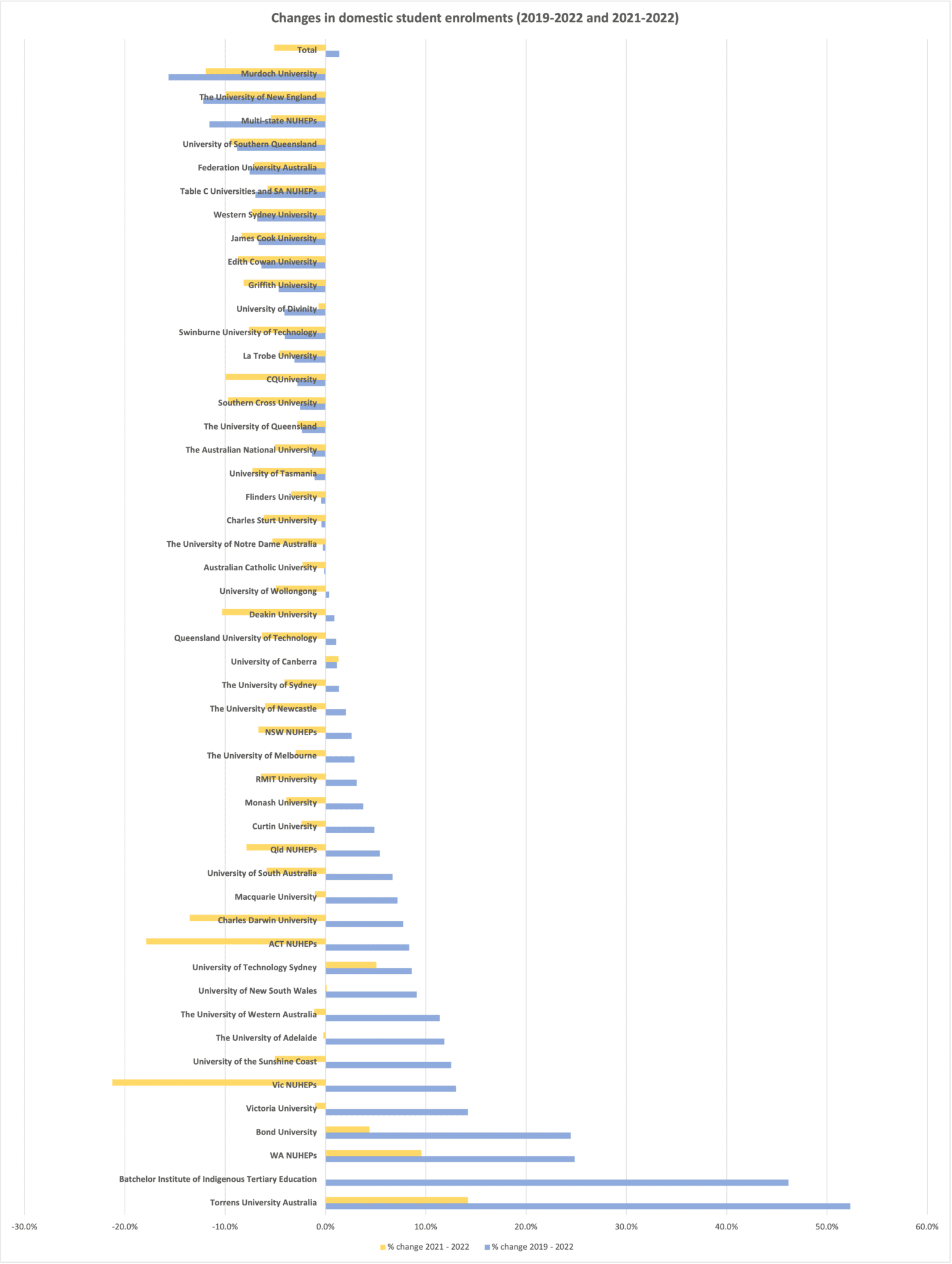
Australian higher education in 2022
The release (finally) of the 2022 higher education student statistics in the week before Christmas has allowed time over the summer break to analyse and reflect on how the sector changed between 2021 and 2022, as well as the changes which have happened since the pandemic hit (by comparing 2019 and 2022) enrolments.
Domestic students
Starting with domestic students – which will be the primary focus of the 47 recommendations in the Universities Accord Panel’s final report when it is made public and the data shows that the sector as a whole saw a very modest 1.4% increase in domestic students between 2019 and 2022, although that was off the back of a 5.4% decrease in domestic students between 2021 and 2022.
There were six universities and a number of Institutes of Higher Education which experienced a 10% or greater increase in domestic student enrolments between 2019 and 2022:
- Torrens University Australia (52.3%)*
- Batchelor Institute of Indigenous Tertiary Education (46.2%)
- Western Australia non-university higher education providers (24.8%)
- Bond University (24.4%)
- Victoria University (14.2%)
- Victoria non-university higher education providers (13.0%)**
- University of the Sunshine Coast (12.5%)
- The University of Adelaide (11.8%), and
- The University of Western Australia (11.4%)^
By contrast Murdoch University (-15.6%), The University of New England (-12.2%) and the Australian College of Theology (the only multi-state Institute of Higher Education, -11.6%) all experienced declines in domestic student enrolments between 2019 and 2022 of more than 10 per cent.
These shifts over the four year period to 2022 help put into context the more recent changes between 2021 and 2022, when some universities and other higher education providers had declines in their domestic student enrolments albeit against a wider pattern of overall recent growth.
What is worth keeping in mind though is that, even for those universities which saw growth in domestic student enrolments between 2019 and 2022, they are on average receiving less funding per student for those additional places. The former government’s Job-ready Graduates reforms reduced average funding per domestic student place and introduced an additional 39,000 places into the higher education system using a ‘growth through efficiencies’ formulation.

International students
With respect to international students – while the Department of Home Affairs data and the PRISMS data are more current, they do not include details of offshore student enrolments by institution which are available in the Department of Education’s student statistics collection.
Once again it is worth contrasting the changes between 2021 and 2022, as well as those between 2019 and 2022 and in looking at the pattern of on-shore versus off-shore enrolments (particularly given the interest in greater offshore activity by both governments and institution in recent years, not just as a temporary response to the COVID-19 pandemic).
The data shows that most universities saw their international student enrolments decline between 2019 and 2022, with the average decline across the sector of -14%. Only the following institutions saw enrolment increases over the four years to 2022:
- Western Sydney University (2%)
- The University of Queensland (3%)
- NSW non-university higher education providers (3%)
- Flinders University (5%)
- Charles Darwin University (6%)
- Western Australia non-university higher education providers (6%)
- Swinburne University of Technology (6%)
- University of Canberra (13%)
- The University of Sydney (22%)
- Torrens University Australia (26%)
- The University of Notre Dame Australia (56%)

By contrast all universities experienced growth between 2021 and 2022 except:
- Charles Sturt University (-41%)^^
- Monash University (-8%)
- RMIT University (-1%), and
- the non-university HEPs in the ACT (-2%) and multi-state (-8%).
Of the nine universities which increased their international student enrolments between 2019 and 2022, some relied on increasing their offshore enrolments – none more so than the University of Sydney which grew its offshore international students by 3818% in just four years.
Others with significant growth (ie more than 100%) in offshore international students between 2019 and 2022 were:
- Queensland non-university higher education providers (2817%)
- The University of Queensland (1410%)
- CQUniversity (976%)
- The University of Adelaide (543%)
- University of South Australia (471%)
- The Australian National University (306%)
- Deakin University (229%)
- Torrens University Australia (212%)
- Victorian non-university higher education providers (161%)
- Queensland University of Technology (152%)
- The University of Notre Dame Australia (140%)
Regrettably the student statistics collection does not provide a breakdown between on and offshore international students at non-university higher education providers. But those which had more than 500 international students enrolled in 2019 and which experienced the highest levels of growth in international students in the four years to 2022 (more than 20% in total) were:
- Stotts Colleges (87%)
- Excelsia College (39%)
- Alphacrucis College (37%)
- SP Jain School of Management (34%)
- Kaplan Business School (29%)
- Curtin College (20%)
A number of larger non-university higher education providers experienced notable declines in their international students in the same time period, including 7 university pathways providers:
- Holmes Institute (-65%)
- Deakin College (-60%)
- Kent Institute Australia (-58%)
- Victorian Institute of Technology (-58%)
- Universal Business School Sydney (-54%)
- Griffith College (-53%)
- South Australian Institute of Business and Technology (-49%)
- Holmesglen Institute of TAFE (-46%)
- Monash College (-40%)
- La Trobe College (-38%)
- Melbourne Institute of Technology (-37%)
- UTS:Insearch (-36%)
- International College of Management, Sydney (-26%)
- William Angliss Institute of TAFE (-25%)
Overall international student enrolments at non-university higher education providers declined 20% between 2019 and 2023. A small number of providers did not provide student data (and were not required to) in 2019, and hence comparisons with their performance in 2023 were not possible. Separately there were also a small number of providers which withdrew their registration between 2019 and 2023, and other new providers which were registered after 2019 and hence comparisons of their student enrolments were also not possible.
——————————————
*The increase in domestic student enrolments at Torrens University Australia (from 8,277 in 2019 to 12,607 in 2022) needs to be understood in part in the context of change in the numbers of domestic students enrolled at Think Education (also part of Torrens Global Education). Domestic students at Think declined by approximately 2,000 in the same period. Overall domestic enrolments at both Think Education and Torrens University were up 23% between 2019 and 2022.
**In 2022 there were 25 non-university higher education providers (Institutes of Higher Education and University Colleges) with their head offices in Victoria. Most had relatively small numbers of domestic students. Four had more than 500 domestic students: Collarts (1,550), Deakin College (1,002), Leo Cussen Institute (600) and La Trobe College (511). Of these three experienced growth in domestic students between 2019 and 2022: Collarts (+63%), Leo Cussen Institute (+22%) and La Trobe College (+25%)
^In 2022 there were only four non-university higher education providers with their head office in Western Australia. Three of them experienced growth in domestic students between 2019 and 2022: Curtin College(-14%, 662 domestic students in 2022), Edith Cowan College (+75%, 161 students), Engineering Institute of Technology (+398%, 508 students), Perth Bible College (-24%, 56 students).
^^ In September 2021 Charles Sturt University announced the end of its 25-year partnership with Study Group Australia. Study Group had managed the university’s Study Centres in Melbourne, Sydney and Brisbane which had educated many international students.




